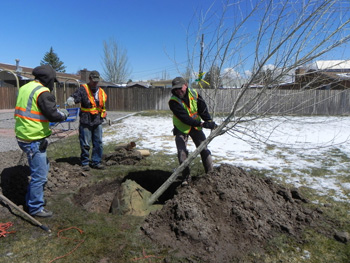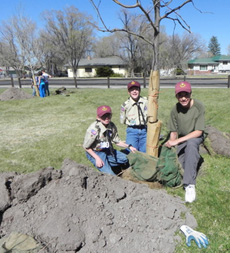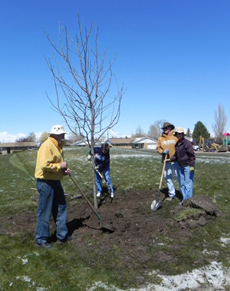Arbor Week 2011 Tree Planting
Alamosans Sling Soil to Plant Trees
|
Alamosa citizens planted trees in city parks during Arbor Week. In fact, the 3 trees for Boyd Park were planted so quickly late comers didn’t even get a chance to sling soil! Boy Scouts, students, Alamosa City Councilmen, and Alamosa Tree Board members were among the shovelers. Alamosa is an Arbor Day Tree City for the 21st year.
The 2.5- to 3-inch caliper trees were larger than those planted the last 2 years. They were “balled and burlapped” and the root balls were very heavy. The Department of Parks and Recreation crew dug the holes using a backhoe after removing the top grass layer by shovel.
Dug holes were at least twice the diameter of the root ball and just deep enough for the root ball with a few inches for a topping bark mulch layer. Shovelers backfilled with the removed soil. Mulch and wire enclosures will be added for protection.
After the first planting in Diamond Park the city crew decided to remove the wire basket and place the trees in the prepared holes using the backhoe for the plantings later in the week. This didn’t provide as much cardiovascular exercise for planters, but possibly saved future back pain. |
Bottom row left to right: Denali Douglas, Leighton Burt, Tim Loosbrock, Mikyla Johnson, Kenai Douglas. Back row: Marilyn Loser (Alamosa Tree Board) Greg Gillaspie (City Council), Rusty Johnson (City Council), Eric Burt (Scout Master). |
| Home owners are typically advised to plant smaller container trees since containers usually have smaller root balls and therefore require smaller holes and are easier to handle (Did I mention the hole should be at least twice the diameter of the root ball? – roots grow out much more than down.). Also, container trees are usually less expensive.
Some nursery people say that it takes 1 year for each 1-inch caliper for a tree to recover from planting. According to this view it will take 2-3 years for the new trees to become established while the smaller trees planted in previous years would take 1-2 years. Watch our park trees over the next few years and decide for yourself. How can you tell? Watch for healthy new branches and growth.
When the project is completed 16 trees, 4 each ‘ShadeMaster’ Honeylocust, Hackberry, Lanceleaf Cottonwood, and Narrowleaf Cottonwodd will be planted in Alamosa parks this May. |

Soloman Archuleta, Roman Cisneros, and Jeremy Arellano remove wire basket from B&B tree. Note wide diameter of planting hole.
|
|
Planters included Boy Scouts Tim Loosbrock, Leighton Burt, & Kenai Douglas along with Scout Master Eric Burt from Troop 307 of Kiwanis. Denali Douglas came along with her brother and lent a hand. Mikyla Johnson and her father Rusty Johnson, City Councilor, are old pros as they regularly lend a hand for planting events. City Councilor Greg Gillaspie joined in and mentioned he had planted such a large tree without the benefit of a backhoe and it took some effort.
Lucy Adams once again shoveled in Diamond Park and Karyl (Alamosa Tree Board) and Tom Scarlett helped in Diamond and Cole Parks. Ron Loser and Leon Moyer also helped. City Crew members who oversaw the safety and effectiveness and did the heavy lifting were Soloman Archuleta, Jeremy Arellano, Roman Cisneros, and Dennis deHerrera.
 |
 |
 |
| Tim Loosbrock, Milyla Johnson, Denali Douglas, and Soloman Archuleta plant a Lanceleaft Cottonwood. |
Boy Scouts Tim Loosbrock, Leighton Burt, and Kenai Douglas pull out the burlap from a new tree before backfilling. In wetter areas of our country, the burlap would probably just rot away in short time. Another tree is being planted in the background. |
Ron Loser, Lucy Adams, and Tom & Karyl Scarlett finish planting a ‘Shade Master’ Honeylocust in the Diamond Park gumbo following a late snow. |




